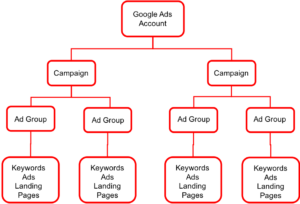
How to Set Up a Successful Google Ad Grants Account – Part 3
Part 3: Optimizing the Landing Pages
Google Ad Grants offer nonprofit organizations the opportunity to spread their message using free in-kind advertising.Recipients get $10.000 USD per month in Google Ads in order to raise awareness and attract donations and volunteers. Setting up a successful Google Ad Grants account includes the following:
- Part 1: Enrolment and campaign structure
- Part 2: Keywords, ad text and ad extensions
- Part 3: Optimizing the landing pages
- Part 4: Managing conversion tracking
- Part 5: Working on continuous optimization
Part 1: Enrolment and campaign structure describes the initial stages of verification and enrollment; how the account is created, and the parameters of the campaign are set. Through the campaign options the advertiser can control the budget and the targeting options.
Part 2: Keywords, ad text and ad extensions provides information on all aspects of keyword identification and selection. Tips on writing effective text for ad and ad extensions are also included.
Part 3: Optimizing the landing pages examines the creation, and optimization of landing pagers. All the relevant tools are presented.
Parts 4 and 5 are currently under development and will be published shortly.
Landing pages and Account structure
As seen in the visual depicting the structure of an account each ad group has it’s own set of keywords, ad text and landing pages.
The keywords trigger the ad, the ad text delivers the message and when the user clicks on the ad they land on the landing page. Since the ads usually include sitelink extensions numerous pages from the organisation’s website serve as landing pages.
Landing Pages = Content
Creating Landing Pages
Landing pages are ultimately pages of the organisation’s website and as such they need to have excellent content. It is important to manage them both as an integral part of the website and a part of the ad group.
The content in the landing page must be directly relevant to the ad text and the keyword that triggered it. It must also clearly deliver what is described in the ad (e.g. an ad about volunteering cannot land on a donations page).
Tips for creating Landing Pages
- Clear main headline. The main headline needs to be clear and without ambiguity. It is important that the visitors feel confident they are in the right place once they land on the website.
- Highlighting benefits. The landing page must communicate the benefits for the visitor and highlight the selling points and motivating factorsfor taking action. It must also highlight the unique features of the organisation.
- Including social proof. The trustworthiness and validity of the organisation need to be corroborated. This can be achieved using certification badges, trust markers, client logos, testimonials or reviews. To that respect, landing pages can also include success stories or testimonies and success metrics (such as the number of people who have received help).
- Single conversion goal. When creating content for a landing page it is advisable to focus on a single conversion point. This will add to the clarity of the message and will minimise distractions and uncertainty.
Tips for optimising Landing Pages
Tip 1: Easy navigation
- Each page needs to be easy to read with a separate page dedicated to each theme. Too much information on one page can be overwhelming for the new visitor.
- The design and the organisation of the page must make it easy for visitors to find what they are looking for. Access to the information in the ad must be clear and straightforward. Buttons must be clearly located and easily identified.
- A menu bar (with submenus if necessary) can help the organisation and the decluttering of the site. A Search bar can also aid visitors navigate.
- The above-the-fold space needs to be taken under consideration and content needs to beprioritized accordingly.
Tip 2: Fresh Content
- It is important to maximise the content of the website and update it on a regular basis. Quality content that is published regularly will increase traffic by appealing to a different audience. It will not only benefit the campaign but also Google ranking. Google favours active websites with solid content. Blogs posts and information on upcoming events are good ideas for fresh content.
- Images help communicate the message and engage the viewers further. Images in landing pages need to portray the product or service clearly without distracting from the main goal of the organisation. Ideally, they are good quality images unique to the organisation.
- Success and Thank you pages that appear after an action is complete (like a donation or a volunteer sign-up) are highly recommended by Google and highly valued by users.
Tip 3: Optimising content
- It is useful to review the complete website and identify gaps among webpages. By going through every page, it is possible to identify where the content is robust and where content is missing. Details about the services might be missing, or parts of the history of the nonprofit. A content audit might also reveal the need to add pages like an Events page, or Staff page.
- Other websites with similar interests can provide inspiration regarding content, writing style, tone of voice. This practice can help advertisers come up with new ideas for improvements.
- The length of the page is important. Most pages are around 350 and 1000 words. If a page is longer than this, it is best to divide into more than one pages. For shorter pages it is probably better to combine them and create one more comprehensive page. Pages that are too short are not ranked highly in Google’s search results.
- Content easy to scan is also helping with users as they usually scan webpages today. Recommended practice is to split content into shorter paragraphs or lists and write important information in bold to facilitate scanning.
Tip 4: Ensure pages are mobile friendly with short loading times
Today, with more and more people using their mobiles to access the web, every website needs to be mobile friendly and load quickly. To that end Google is offering various tools presented here.
- Firstly, it is essential to use a responsive web design that can accommodate mobile access. Organisations can learn the Principles of mobile site design and how to Create an effective mobile site on the Google website. Advice includes tips like:
- Test on various devices
- Keep menus ‘short and sweet’
- Provide a visual calendar for selecting dates
- Design efficient forms
- Organisations can evaluate their landing page experience on mobile devices using the ‘Landing Page’ metrics on the platform. Google’s Mobile friendly test measures how mobile friendly the pages are, and AMP Validator test indicates how often AMP pages load as valid AMP pages or not.
The landing page experience
Nonprofits need to be aware that the Google Ads system regularly visits landing pages and websites and evaluates the landing page experience. The landing page experience is a measurement of how well the pages give visitors what they look for when they click the ad. Google analyses the data through an automated system and the measurement affects the Ad Rank and thus the CPC and the auction position. Ads will show less often if they are linked to websites with bad user experience.
It is also necessary to ensure the page loads quickly, whether on a computer or a mobile device. The page must load in 3 seconds or less otherwise users leave before actually visiting the page. Google offers a tool for Testing the Site which also provides quick fixes.
Closing note
In Part 1 we examined the Enrolment and Campaign Structure of a Google Ad Grants account. In Part 2 we discussed how the right Keywords will show the ads and precise Text will entice viewers to click on the ad. Once they click, they land on the designated landing page. In this post the creation and optimisation of Landing Pageswas presented. Next up, Conversion Tracking.
The series How to set up a successful Google Ad Grants account comprises of:
- Part 1: Enrolment and campaign structure
- Part 2: Keywords, ad text and ad extensions
- Part 3: Optimising the landing page
- Part 4: Managing conversion tracking
- Part 5: Working on continuous optimisation




